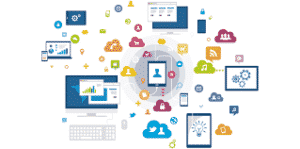Learning
Mindboost has been giving quite a bit of thought recently to blended learning and building on our previous thoughts about learning, whether there’s a right and a wrong way to approach learning and whether a specific strategy or style can be applied, which has got the monsters thinking more about the blends of learning. Having been involved with a number of corporate businesses recently and discussing approaches, a very different style seems to be being taken by each business and for very different reasons.
Obviously each business is different and has different drivers and motives for applying their own style, and a tailored approach needs to be applied based on a multitude of things such as, culture, maturity, demographic, investment, requirements, environment, etc, etc.
To cloud thier thoughts, the monsters are also challenged with the very differing views and project implementation styles of a waterfall approach and an agile approach. Our default has been waterfall for a number of years, but after having exposure to a software startup development environment we’ve really seen the benefits of utilising an agile approach and the ability to deliver a viable product quickly to customers using this approach.
Digital Learning

In recent years, we’ve seen much debate about the benefits of digital training vs traditional face to face training. The rise in popularity of digital training and innovative LMS as a credible alternative to face to face training, or to fortify classroom based programmes has changed many aspects of learning and development in the workplace and personal development, with many businesses seeing reduced costs, faster time to competency and improved attraction for new employees.
Being directly responsible for the rollout of digital learning in a ftse 100 company and challenged with the speed of which people feel competent to undertake their tasks, while also providing added value to people and enabling claims defensibility for the business. We can speak with a great level of knowledge, feedback and experience.
Amplification
The same challenges exist with what ever route is taken; how can we amplify learning and capitalise on the opportunities of supporting behavioural changes, while being cost effective. Digital learning can support the amplification, reach & availability of training, but is not a replacement for poor training and cannot mask this. The approach when crafting a great digital learning experience should be very similar to that taken to craft a great face to face learning experience.
The challenge from what we’ve experienced recently is, what is a ‘great’ learning experience? What does it look like, what should it cover, how can it be created and who determines what ‘great’ looks like?
Blended Learning
We believe a great learning experience starts with a genuine need from customers. What is their challenge, what are the knowledge gaps and what are we trying to fix? It’s about keeping things simple and servicing the genuine requirement and the only way to know the answers is by asking the customer and getting to know their challenges!
Once the above has been understood, the next step is then to use an Instructional Designer to work up an engaging and novel blended approach to filling the gaps in, using all the tools available ‘blended learning’.
There is no doubt that technology and digital learning alone can offer some very substantial and measurable rewards. We have been an advocate of elearning for many years and have supported business to recognise substantial benefits from utilising elearning and a great learning experience. We do however need to be very mindful of not just applying one way of achieving the end result and simply by adding a forum or chat environment to a course page does not mean this is blended!
What are the benefits of digital learning and elearning?

One of the biggest and measurable benefits of a digital learning programme over the classroom equivalent is the potential for substantial cost savings. We have completed many reviews on ‘Return on Investment and cost savings and have reported potential savings in the £millions. The obvious reasons for this are no travel requirements, no accommodation costs, limited time out of the business and all the associated overheads of trainer costs, premise cost and printing being eliminated.
Scalability and repeatability
The other benefit is the quantity of learners that can be trained at the same time. Given the right technology, this can be limitless and each learner can learn at any time, on any device in any location, given access to broadband.
This is of great value where a business wants the flexibility to empower their team to complete the training how they want to complete it, but also for businesses that want to train large amounts of people in a short space of time.
The other benefit is if learners want to recap on the learning again. Not many people attend the same classroom course more than once, but given the opportunity learners can complete elearning as many times as they want and often do to support continued learning and information recal.
Tracking and reporting
One of the most powerful things about digital learning is the ability for this to be automatically recorded and reported on. In businesses now, we expect data and reporting to be readily available at the press of a button. Any credible learning management system and learning record store (LRS) will do this and in a matter of seconds, provide meaningful data to let a business know who has and hasn’t completed training and when they completed it.
In businesses now, we expect data and reporting to be readily available at the press of a button. Any credible learning management system and learning record store (LRS) will do this and in a matter of seconds, provide meaningful data to let a business know who has and hasn’t completed training and when they completed it.
If Google Analytics is also added to a site, you also get an overwhelming amount of information about the types of device used, location, etc, etc.
The biggest challenge is deciding how to use the information, the best and most information way to present it and making decisions and impacting the business based on this data.
Personalised learning
With a move to machine learning and pre-emptive learning, systemising training can make an experience personalised to every learner. Imagine a programme that is automatically tailored to the learners needs. This would mean the programme looks very different for each person, but the learner would only need to learner the information they need, rather than learning lots of information because that is the format of the programme.
This is similar to how everyone uses Google, you only search for stuff you want to know about, rather than looking at everything and then deciding what information you will remember.
This could not only save valuable time, but also make learning very relevant to each person.
Great design
 The scope for offering course materials in a variety of media is much greater with an digital learning courses than with just classroom-based training. As well as the opportunity to recycle and reuse a digital programme across multiple sectors and businesses.
The scope for offering course materials in a variety of media is much greater with an digital learning courses than with just classroom-based training. As well as the opportunity to recycle and reuse a digital programme across multiple sectors and businesses.
The key I find to gaining learning engagement in online learning are a few areas:
- Well designed graphics
- Bespoke images
- Easy and straight forward access to the content
- Relevant content
- Simplified information
The great thing about digital learning is that they are now so many types of assets that can be used in digital learning, such as, video, images, audio, text, animations. The challenge from a design point of view is which ones/combinations are suitable for the piece of learning.
Collaborative learning
One of the best ways to connect learners to connect is to get them to generate the content. Using guerrilla style video, really helps to get colleagues and learners connected with content, especially if the messages in the videos are sincere and relevant to the audience.
Final thoughts
This is a topic that prompts lots of discussion and a lot of alternative ideas, but it feel that learning design is currently in a great place with lots of options on how it can be created and the assets that can be used. A bit like a kid in a sweet shop, which ones will you pick today?
Further information
If you want to know more about us, the courses we offer or need any further information please feel free to contact us.





